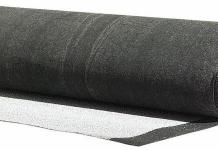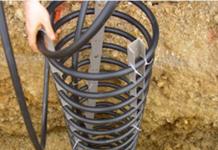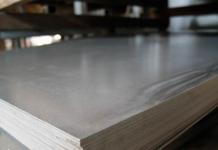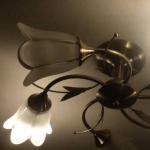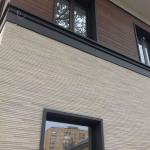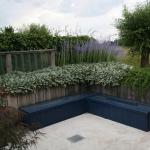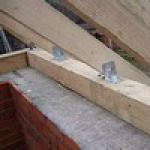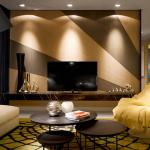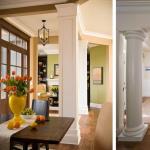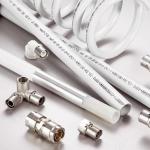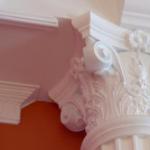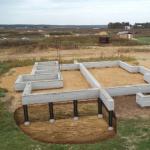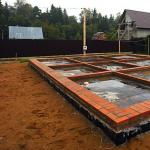The ventilation facade made of fiber cement boards is a rectangular cladding element with a decorative finish. Fiber cement is 80-90% cement, the rest is water, sand and cellulose fibers (fiber). Cellulose in this material plays the role of reinforcement. Sometimes instead of it, fiberglass is introduced into the composition.
Due to the special method of installation, a gap remains between the ventilated facades and the walls of the building, ventilation is constantly carried out, which helps prevent the occurrence of many problems inherent in other types of facades. A layer of thermal insulation is placed in the gap.
Fiber cement boards and their decorative coating are hardened during the manufacturing process to increase strength. A water-repellent protective layer of polyurethane and acrylic is applied to the front layer of the finished board. Paint or other coating is applied to the treated surface. The last layer on the front side is photoceramic or hydrophilic substances that form a film that ensures self-cleaning of the facades. Apply on the back side

Finishing options for fiber cement boards:
- plain colored panels;
- stone chips in the color of natural stones;
- imitation of a brick wall;
- imitation of masonry;
- under wooden siding;
- under decorative plaster;
- mosaic, etc.
The service life of fiber cement facades, depending on the method of decorative finishing, is from 20 years.
Advantages and disadvantages of a ventilated facade made of fiber cement boards
When choosing paint for fiber cement slabs, must be based on the already existing color scheme of the house, and ... bracket for ventilated facades- what is it, functions, types, installation and manufacturers (5.00 out of 5).There are several types slabs For facade works: fiber cement, wood-plastic HPL-panel, metal ... Newest plates for cladding ventilated facades buildings, have a number of unique features
Traditional facade finishing technologies associated with the use of plaster solutions cannot be considered ideal. Even with the most careful work, they suffer from significant shortcomings.
First, you need to carefully prepare the surface, taking into account the condition and absorbent properties of the material of the load-bearing wall.
Secondly, in winter, a wet finishing process is not possible. Thirdly, a thin shell of plaster, even reinforced with a mesh, quickly loses its appearance. It cracks and flakes off the wall when wet and frozen.
Developers had to put up with the listed shortcomings until fiber cement panels were created for the exterior of the house. Japan is considered to be their country of origin.
Pragmatic islanders reasoned something like this:
- It is necessary to create a finish that does not have chemical contact with the wall material (it will not fall off and crumble).
- It should be tight, but flexible enough to avoid cracking.
- The cladding must be durable and as resistant to the external environment as possible.
- Flammability and toxicity are excluded.
- The design of the sheet material should ensure easy installation.
The first component for the new composition was found without problems. They became cement. It is durable, resistant to moisture, frost and heat. In order to prevent the thin layer of the solidified solution from cracking, cellulose fiber was introduced into it. It performed the role of micro-reinforcement, perceiving deformations and increasing plasticity.

The new material pleased the creators with an exceptionally high textured variety. Until the moment of setting, the cement-cellulose composition can be given any shape (under a tree, under a brick or a wild stone). The color gamut of the new material is varied over a wide range by adding alkali-resistant dyes to the raw material.

As you know, hardened cement mortar actively absorbs water. For this reason, fiber cement facade panels are covered with a protective layer of varnish or silicone at the final stage of production.
Main characteristics, dimensions
Technical parameters of fiber cement panels normalize GOST 8747-88.
There are not too many of them in this material:
- density not lower than 1.5 g/cm3;
- frost resistance of at least 100 cycles (40-50 years of operation);
- water absorption should not exceed 20% of the mass of the plate;
- bending strength not lower than 24 MPa;
- impact strength - not less than 2 kJ/m2;
- average weight of 1m2 from 16 to 24 kg.
Compared to corrugated asbestos-cement slate, fiber-cement panels better resist bending forces (24 MPa vs. 16 MPa). This means that they can withstand intense wind loads and moderate point impacts.
On the construction market, panels are presented in a wide range of sizes. Japanese-made products can be classified as fiber cement siding. These plates are quite long (1820 and 3030 mm). They have a small width of 455 mm and a thickness of 12 to 18 mm.
For domestic and European panels, the dimensions (mm) are different:
- 770x1200;
- 306x1590;
- 455x1593;
- 1190x1560;
- 1220x2440;
- 190x3600;
- 1200x1500;
- 1220x2520;
- 1220x3050;
- 3000x1500;
- 3600x1500.
The thickness of Russian-made panels is from 6 to 16 mm.
In addition to size, fiber cement boards differ in the shape of the joint edge. For those that are mounted on clamp plates, the long sides have protrusions. They provide a tight fit of the cladding to the frame.
The fiber cement board for the facade can be painted at the factory or go to the consumer without painting. In the second case, it is tinted at the facility after installation is completed.
Fiber cement board reviews
Let's say right away that this type of finish is ideal for installing a ventilated facade - a design that is beneficial in terms of energy saving and protection of load-bearing walls.
The high strength, incombustibility, durability and low weight of the fiber cement composite are the best suited for the harsh operating conditions of the external cladding. Therefore, the nature of the reviews about this material is mostly positive. Installation of a protective screen made of fiber cement boards is simple and can be carried out at a high speed.
The only condition that must be observed at the selection stage is the orientation to trusted manufacturers who provide a quality guarantee for their products.
Mounting Features
The easiest option for attaching fiber cement boards is to a supporting frame made of planed wooden bars with a section of 5x5 cm, attached to the wall with dowels. They are mounted in such a way that the joints of the plates fall on the racks of the frame. The step of the wooden crate must be at least 60 cm.
The installation of the fiber cement board is carried out using stainless steel self-tapping screws. They are screwed into the frame through holes drilled in the plates. The depth of installation of self-tapping screws into the panel should be such that their caps can be hidden using colored sealant paste. It is purchased along with the facing material.

Since the panels of the fiber cement composition are quite hard, their cutting must be done using a grinder with a carbide disc. After completion of the work, the joints of the plates are treated with a sealant to prevent moisture from entering the space between the cladding and the wall.

On a wooden frame, the plates can be placed not only on self-tapping screws, but also on steel plates-clamps. In this case, you need to use a plate with milled edges that create a hidden seam. To increase the tightness of the joints, a special seam bar is attached to the vertical racks of the crate, or a wooden bar is covered from above with a sealing tape.

Fiber cement siding installation
A more complex option is a ventilated facade with fiber cement panels cladding. In this case, you have to make two wooden or metal crates. The first is attached to the wall of the house horizontally. Mineral wool slab insulation is placed in the space between the bars. Then it is covered with a vapor barrier film and the second frame is already mounted on it in the vertical direction, fixing its racks to the horizontal bars of the crate.

This installation technology allows you to create an air gap between the insulation and the fiber cement board. Through it, water vapor is released into the atmosphere, penetrating from the premises through the walls of the building. The fastening of the plates to the crate in this case is also carried out using self-tapping screws. You need to screw them into the slab no closer than 3 centimeters from its edge so that the edge does not break off. Before installing the cladding, docking profiles are placed in the corners and around the openings, covering the ends of the plates and starting strips.

Professional installation of fiber cement panels involves the use of a metal frame. Steel brackets are attached to the wall before installation. Then, a rigid insulation is mounted on dish-shaped dowels and a horizontal carrier profile is fixed on the brackets.
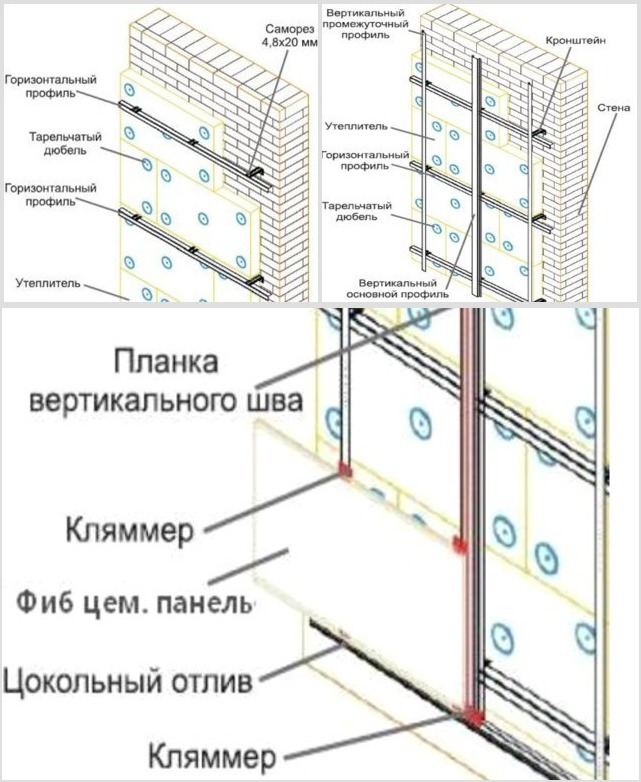
After that, a vertical crate is placed and the installation of panels begins. It is carried out in a hidden way, using clamp plates equipped with hooks for fixing the edges of adjacent plates.
All seams between the plates after installation is carefully covered with sealant.
Estimated prices, well-known manufacturers
The creators of fiber cement panels are the Japanese, so their companies occupy a dominant position in the market. They offer quality material, the cost of which cannot be called low. The most famous are two brands: Kmew (Key Em Yu) and Nichiha (Nichiha). The estimated average cost of 1m2 of Japanese panels for 2017-2018 is 1600 rubles.
Another well-known brand in Russia is the Belgian company Eternit (siding - Cedral, plates - Equitone). Prices for fiber cement siding from this manufacturer are balanced in the middle price category and amount to 900-1800 rubles / m2, the price of boards starts from 2500 rubles / m2.
Of the Russian manufacturers of fiber cement boards and siding, the companies Rospan, Kraspan, and Latonit can be noted. With a sufficiently high level of quality, their goods are significantly cheaper than Japanese ones. The average cost of products of the mentioned domestic firms is 800 rubles/m2.
One of the modern methods of finishing the facades of buildings and structures is the arrangement of ventilated facades. For their creation, fiber cement facade panels are used.
Composition of fiber cement panels
Fiber cement facade panels are a composite material, the main raw material for the manufacture of which is a mixture of cement, mineral and synthetic fillers, as well as cellulose fiber. In some brands of fiber cement panels, additives such as mica and quartz sand are introduced, which increase the strength properties of the finishing material.
Despite the fact that the building materials market offers facade panels of both domestic and foreign production, there are no significant differences between their performance characteristics, since they are produced using identical technological processes.
Production of fiber cement panels
Fiber cement facade panels are obtained by pressing and autoclaving the raw materials. In order to obtain high-quality products, the pressure during pressing must be at least 600 -650 N / cm 2, and the temperature regime must be strictly observed and vary in the range from 170 to 175 0 C. With strict observance of the technological process, facade fiber cement panels are obtained, having homogeneous stable structure and uniform density.

The strength of the finishing material is sufficient to withstand significant mechanical loads.
The final stage in the production of finishing material is its coloring. Panels can be covered with both smooth and textured paint. Texture paint allows the production of facade panels imitating artificial or natural stone.
In order to further protect the finishing material from external factors such as ultraviolet radiation and precipitation, a layer of protective varnish is applied to the fiber cement panels. The use of high-quality dyes and varnishes allows you to create unique and unique textures and surface colors.
After production, the finishing panels go through a stage of testing to ensure that the characteristics of the material correspond to the relevant quality standard.
Advantages
The main advantages of fiber cement panels include their high strength, environmental friendliness and durability. In terms of their physical and mechanical properties, fiber cement panels are close to porcelain stoneware facade tiles, they are fireproof, which ensures high fire safety for this finishing material.
The low hygroscopic properties of the material allow the use of fiber cement panels even in regions with harsh climatic conditions.
 Fiber cement panels are made in various shapes and sizes, but they are all equipped with special ventilation slots that allow air to circulate freely between the panel and the heat-insulating layer.
Fiber cement panels are made in various shapes and sizes, but they are all equipped with special ventilation slots that allow air to circulate freely between the panel and the heat-insulating layer.
Fiber cement facade panels are a universal finishing material that can perform not only a decorative, but also a heat-insulating function. Fiber cement panels are used to create partitions inside buildings and structures.
Finishing a building with fiber cement panels is quite simple, since this material does not require pre-assembly surface preparation. The key advantage of this finishing material is its high performance and low cost.
Flaws
This finishing material does not have significant drawbacks, the only thing that can be noted is the lack of aesthetic appearance. The facade of a building finished with fiber cement panels is not as expressive as a facade lined with decorative bricks or stone-like tiles.
This drawback refers to subjective forms of assessment, since the finishing of buildings and structures with fiber cement panels can have not only a fairly aesthetic appearance, but also high performance.
Installation of fiber cement panels
In order to install fiber cement panels, it is necessary to mount brackets on the walls of the structure, while taking into account the fact that the length of the brackets must be greater than the thickness of the heat-insulating layer. This is done to ensure sufficient air circulation between the thermal insulation layer and the finishing material.
Then, the installation of a heat-insulating layer is carried out, for the fastening of which dowel-umbrellas are used. A metal frame is mounted on top of the heat-insulating layer.
It is necessary to begin the installation of a metal frame with the installation of its horizontal elements, after installation of which, vertical elements are mounted. Fiber cement panels are attached to a metal frame. Depending on the thickness of the finishing material, fasteners such as self-tapping screws or clips are used.
Important! The use of self-tapping screws is advisable if the thickness of the fiber cement panels does not exceed 15 mm. If fiber cement panels are fastened with self-tapping screws, then a sealing tape must be laid between the frame and the finishing material.
The joints between the fiber cement panels are filled with a sealing mixture. To fill the joints, you should choose a sealing mixture of the same brand as the fiber cement panels themselves.
To decorate the corners of the building, a metal corner or corner-shaped components are used. Both identical and contrasting components can be used to decorate corners, window and door frames, the latter will make it possible to make a bright accent and uniqueize the design of the facade.
For details on installing fiber cement siding, see the video.
<
Conclusion! Ease of installation and high performance characteristics of fiber cement panels allow you to finish the facade of the building yourself. To do this, it is necessary to strictly observe all the technological stages of installation.
Currently, many building materials are used for home decoration. Gradually gaining popularity facade fiberboard, which has high strength and retains its characteristics regardless of operating conditions. The surface of the panels has different colors and has an original texture. made of composite concrete. This material uses special fibers that increase the strength properties of fiber cement boards. Developers are attracted by the quality of products and affordable installation technology.
What is facade fiberboard
Fiber cement slabs for facades are a modern facing building material with a rectangular shape.
For the manufacture of fiber cement products, the following components are used:
- Portland cement used as a binder. Thanks to the binding component, the finished product acquires the necessary margin of safety and resistance to moisture;
- screened sand of river or quarry origin, used as aggregate. The presence of foreign impurities and clay inclusions in the sand is not allowed;
- fiber fibers that increase the resistance of products to bending and compensate for tensile forces. Thanks to the spatial reinforcement, the rigidity of the finished product increases;
- modifying additives and special fillers, thanks to which products retain their properties under the influence of negative temperatures and high humidity.
Plates are environmentally friendly. After all, the raw materials used for the manufacture of panels do not contain toxic components, and during their operation, substances harmful to human health are not released.
The main manufacturers of fiber cement panels for reinforcement use fiber fibers of various origins, made from the following materials:
- polypropylene;
- asbestos;
- acrylic;
- polyamide;
- polyethylene;
- polyester;
- basalt;
- viscose;
- cotton;
- nylon;
- cellulose;
- steel.
Reinforcement is also made with glass fibers resistant to alkaline environment. The type of aggregate used and the fiber material is determined by the manufacturer, depending on the specific brand of boards.
Facade fiberboard is used in various areas to solve a wide range of tasks:
- protection and decoration of the external walls of buildings;
- construction of ventilated facades;
- finishing of the basement part of the building;
- interior cladding of residential and industrial premises;
- improvement of roof structures;
- sheathing of internal partitions.
 Light weight, practical incombustibility, excellent sound and heat insulation provide comfortable living in a house, the walls of which are finished with fiber cement boards
Light weight, practical incombustibility, excellent sound and heat insulation provide comfortable living in a house, the walls of which are finished with fiber cement boards The boards are used in the field of civil engineering, in the industrial sector, and are also used in the manufacture of furniture. Protective and decorative coating allows the use of products in various conditions. To create ventilated facades, the slabs must be attached to a pre-mounted frame made of metal profiles or wooden slats. Fiber panels allow you to implement original solutions for external and internal design.
Facade panels made of fiber cement boards - varieties of composite products
When thinking about using fiber cement boards to decorate your own home, you should understand the types of products offered. Indeed, in appearance, fiber cement panels offered in specialized stores differ significantly from each other.
Visual differences between products:
- color spectrum. From the many fiber cement boards presented, it is easy to choose a finishing material that harmonizes in color with the main structure;
- embossed surface texture. The quality of the relief surface of the product is difficult to distinguish from natural materials;
- the presence of a protective coating. A special coating applied to the surface protects the material from fading and moisture.
The most common plates imitating the following materials:
- burnt or aged brick. Panels with imitation of a brick wall are in perfect harmony with the design of modern residential and industrial buildings. The color of the panels reproduces the color of various types of bricks, from gray to terracotta;
- a natural stone. Facade cladding with slabs, the texture of which imitates stone, is quite popular. After all, financial opportunities do not always allow the use of quite expensive natural material. In addition, it is not always possible to fix heavy stone slabs on the facade;
- wood of various species. The facade of the building, decorated with wood-like slabs, creates a feeling of harmony and warmth. Fiber cement trim, unlike wood cladding, does not rot and is also fireproof.
 The main direction of application of fiber cement boards is the decoration of the facade of buildings.
The main direction of application of fiber cement boards is the decoration of the facade of buildings. Fiber cement products are also different:
- manufacturing method. Autoclaving technology is used, as well as plate molding under high pressure;
- anti-vandal coating. The protected panels differ in the increased wear resistance and reliability;
- ability to resist moisture penetration. Products with increased and ordinary moisture resistance are made;
- fire resistance. Depending on the technology and raw materials used, there are boards with high and standard fire resistance;
- overall dimensions. Each manufacturer carries out the production of plates in individual forms, having different sizes;
- surface texture. Matte, laminated fiber panels, as well as textured products are produced;
- specific gravity of the composite array. Plates with an average density are used in private housing construction, and products with an increased specific gravity are in demand in the industrial sector.
In the process of manufacturing fiberboards, various types of fibers are used, the choice of which affects the strength properties and performance characteristics.
Facades made of fiber cement boards - advantages and disadvantages of panels
Fiber cement facade slabs have a set of serious advantages. Main advantages:
 The walls of buildings sheathed with this material maintain a comfortable microclimate at any time of the year.
The walls of buildings sheathed with this material maintain a comfortable microclimate at any time of the year. - environmental friendliness of products. For the manufacture of fiber panels, environmentally friendly raw materials are used that do not adversely affect human health;
- ability to absorb external noise. In terms of soundproofing properties, the slabs are comparable to double windows. Increased sound absorption is achieved due to the structure of the composite material;
- improved thermal insulation properties. After finishing the outer walls of the building with fiber cement panels, heat loss is significantly reduced, and the cost of heating the room is also reduced;
- Fire safety. Finishing slabs are classified as low combustible and difficult to ignite types of cladding and have a reduced smoke generating ability. In terms of fire resistance, boards are superior to other materials;
- resistance to temperature extremes and deep freezing. The structure of composite concrete is preserved for 140 freezing cycles with further thawing;
- resistance to the negative effects of natural factors. Fiber cement products retain their original structure and are not destroyed under the influence of ultraviolet rays;
- neutrality to the formation of fungal colonies and the appearance of mold. On the outer and inner surface of the decorative cladding, conditions for the development of microorganisms are not created;
- resistance to destruction as a result of corrosion processes. Despite the operation in conditions of high humidity, the material is not subject to corrosion;
- ease of installation operations and the ability to install fiber panels, regardless of temperature conditions and seasons. Installation of plates does not require special training;
- air permeability of composite concrete. Due to the presence of the smallest pores inside the material, an effective removal of excess water vapor from the room is ensured and a comfortable humidity is maintained;
- high decorative properties. Manufacturers produce facing products with different textures and extended colors;
- the ability to self-clean as a result of exposure to precipitation. Upon contact with rainwater, layers of dirt are quickly removed from the surface of the fiberboards;
- increased margin of safety and wear resistance. Decorative plates are able to perceive bending loads, mechanical impact and at the same time maintain the integrity of the structure;
- long period of operation of products. The service life of fiber cement panels manufactured at industrial enterprises from high-quality raw materials is more than 100 years;
- versatility. Fiber cement products made of composite concrete are used for decorative finishing of external and internal walls of buildings, as well as for the arrangement of ventilated facades.
 Good for machining
Good for machining Among the other advantages of products, it should also be noted:
- affordable price of facing material, which is combined with a high level of quality;
- a small mass of products, due to which the load on the foundation base is reduced;
- maintaining the original overall dimensions and the absence of shrinkage during operation;
- the absence of salt stains on the decorative surface of the products, as well as rust spots.
Along with the advantages, there are also a number of disadvantages. The disadvantages of the finishing material include:
- increased water absorption. In conditions of high humidity and in direct contact with precipitation, the degree of moisture absorption of the plates reaches 10 percent;
- the need for additional application of a paint coating on a new fiber cement product, the surface of which was not subjected to coloring under production conditions;
- significant fluctuations in the mass of products manufactured by different manufacturers. Having decided on the type of decorative plates, it is necessary to determine the load on the supporting frame and the foundation of the building;
- the need to attract an assistant to perform installation operations. Despite the simplicity of the technology, the assistant will facilitate the installation of products that have increased dimensions and weight.
Despite the disadvantages, professional builders and individual developers prefer fiber cement boards due to their increased performance.
What are the characteristics of fiber cement boards
Operational characteristics and overall dimensions of products are regulated by the requirements of the current standard.
 The composition of fiber cement boards includes materials that are safe for human health: cement, reinforcing cellulose fibers, mineral fillers
The composition of fiber cement boards includes materials that are safe for human health: cement, reinforcing cellulose fibers, mineral fillers Let's take a closer look at the main indicators:
- the specific gravity of the composite material is more than 1.5 g/cm3;
- the degree of moisture absorption - 6-10% of the total weight;
- frost resistance - above 140 cycles;
- sound absorption value - 26-30 dB;
- impact strength - above 2 kJ / m2.
Dimensions of products depend on the manufacturer of products and are:
- length - 1.5-3.6 m;
- width - 0.20-1.5 m;
- thickness - 0.6-3.5 cm.
Fiber cement panels of domestic production with a thickness of 8 mm with dimensions of 1.2x1.5, 1.5x3.0, and also 1.5x3.6 m are very popular. Compliance with the manufactured finishing products is confirmed by a package of permits, which include certificates of conformity, sanitary hygienic conclusions and results of laboratory control.
What technology is used by manufacturers of fiber cement panels
The manufacture of fiber cement products is carried out at specialized enterprises using industrial equipment and subsequent laboratory control of the finished product.
At the initial stage, the following works are performed:
- Preparation of raw materials.
- Mixing the working mixture.
- Adding dye.
- Formation of blanks.
 High resistance to bending and compression
High resistance to bending and compression The technology includes two main stages:
- Pressing the prepared working mixture to provide increased density, reduce hygroscopicity and increase strength properties. As a result of pressing, the required relief is formed on the outer side of the plates.
- Autoclave treatment of prepared blanks in special containers at elevated pressure. As a result of high-temperature treatment in autoclaves, cement particles and aggregates are sintered into a single mass.
At the final stage of the technological cycle, the following operations are performed:
- Cutting the panels removed from the autoclave into blanks with the required dimensions.
- Grinding the cutting zone and the finish surface to the required quality.
- Applying a protective and decorative coating to the surface.
All fiber cement products are subjected to laboratory control before being sent to the warehouse. At the final stage, the compliance of products with the requirements of the standards is checked and products with deviations are rejected.
Technological features of the installation of fiber cement boards
Those who have used fiber cement boards for home decoration are familiar with the specifics of installation. When planning to mount facade panels from fiber cement boards for the first time, you should familiarize yourself with the features of their installation and carefully study the technology.
When performing installation operations, adhere to the following algorithm:
- Check the flatness of the facade surface.
- Eliminate height differences and local defects.
- Attach the mounting brackets.
- Lay and fix the sheet heat insulator.
- Attach the windscreen with an overlap of 0.2 m.
- Assemble the elements of the supporting frame.
- Attach the fiber cement cladding to the frame.
- Fill the joints between the panels with sealant.
After completion of the installation operations, it is necessary to fix the corner elements that protect the end planes of the panels.
Conclusion
Using fiber cement board facade panels, it is easy to give any building a modern look. To perform installation operations, you should carefully study the technology. In the absence of installation skills, use the services of qualified installers. They will promptly perform all operations and will not make mistakes. A well-installed cladding will last for decades.
